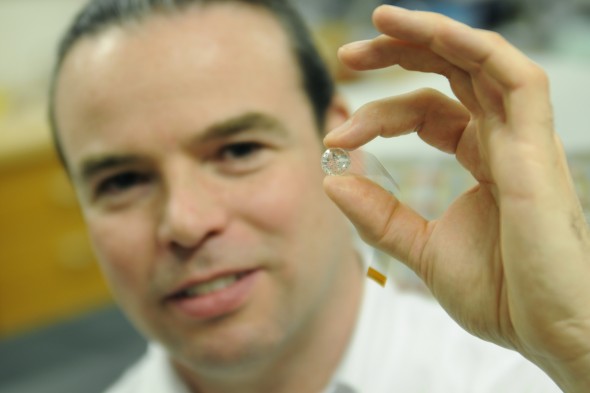Early diagnostic tool for glaucoma to prevent blindness

John Hetling is developing a contact lens that helps physicians see retinal changes caused by glaucoma. UIC Photo Services (click on image for larger file)
Glaucoma is one of the leading causes of blindness in the world, but it can be halted or slowed with early diagnosis and treatment.
Unfortunately, current methods of diagnosis can’t recognize glaucoma until the disease is well advanced.
UIC researchers in bioengineering and ophthalmology are working to develop a technology for more effective diagnosis.
Their research is among the projects that will benefit from a $6.5 million pledge to the UIC department of bioengineering from 1974 graduate Rick Hill and his wife, Loan.
In glaucoma, a specific type of cells in the retina (retinal ganglion cells) are lost. During a standard eye exam, a diagnostic test shines a light on the retina and gets back an electrical neural signal that provides a general measure of retinal health. However, the test is not sensitive to small or localized changes.
John Hetling, associate professor of bioengineering, is working with ophthalmology researchers Thasarat Vajaranant and Charlotte Joslin to develop a new diagnostic technology based on the Contact Lens Electrode Array (CLEAr Lens), a lens made of the same material as an ordinary hard contact lens, but with an array of electrodes printed on it.
When the physician shines a light into an eye wearing a CLEAr Lens, the electrodes can measure the health of the retina in finer detail.
With current techniques, 60 percent of an individual’s retinal ganglion cells may be lost before glaucoma is diagnosed. Hetling and his colleagues believe their work will lead to earlier detection and treatment that preserves a patient’s vision.
The CLEAr Lens draws on expertise in engineering design, microfabrication, biomaterials, instrumentation development, electrophysiology, contact lens design and medicine.
The lens itself was developed in collaboration with Justin Williams, associate professor of biomedical engineering at the University of Wisconsin, Madison.
“This is the type of translational, multidisciplinary problem that bioengineers are trained to solve,” Hetling said.
